Sizes and Temperature Profiles of Quasar Accretion Disks from Chromatic Microlensing
Author(s)
Blackburne, Jeffrey A.; Pooley, David; Schechter, Paul L.; Rappaport, Saul A
Downloadschechter1.pdf (482.8Kb)
OPEN_ACCESS_POLICY
Open Access Policy
Creative Commons Attribution-Noncommercial-Share Alike
Terms of use
Metadata
Show full item recordAbstract
Microlensing perturbations to the flux ratios of gravitationally lensed quasar images can vary with wavelength because of the chromatic dependence of the accretion disk's apparent size. Multiwavelength observations of microlensed quasars can thus constrain the temperature profiles of their accretion disks, a fundamental test of an important astrophysical process which is not currently possible using any other method. We present single-epoch broadband flux ratios for 12 quadruply lensed quasars in 8 bands ranging from 0.36 to 2.2 μm, as well as Chandra 0.5-8 keV flux ratios for five of them. We combine the optical/IR and X-ray ratios, together with X-ray ratios from the literature, using a Bayesian approach to constrain the half-light radii of the quasars in each filter. Comparing the overall disk sizes and wavelength slopes to those predicted by the standard thin accretion disk model, we find that on average the disks are larger than predicted by nearly an order of magnitude, with sizes that grow with wavelength with an average slope of ~0.2 rather than the slope of 4/3 predicted by the standard thin disk theory. Though the error bars on the slope are large for individual quasars, the large sample size lends weight to the overall result. Our results present severe difficulties for a standard thin accretion disk as the main source of UV/optical radiation from quasars.
Date issued
2011-02Department
Massachusetts Institute of Technology. Department of Physics; MIT Kavli Institute for Astrophysics and Space ResearchJournal
Astrophysical Journal
Publisher
IOP Publishing
Citation
Blackburne, Jeffrey A. et al. “Sizes and Temperature Profiles of Quasar Accretion Disks from Chromatic Microlensing.” The Astrophysical Journal 729.1 (2011): 34.
Version: Author's final manuscript
ISSN
0004-637X
1538-4357